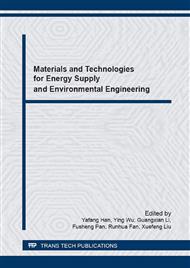p.294
p.299
p.308
p.315
p.321
p.328
p.335
p.344
p.352
Analysis on Influence Factors of Greenhouse Gas Emissions of Magnesium Production Process
Abstract:
Magnesium is a promising lightweight and green metallic engineering material, but the environmental impact of primary magnesium production stage, especially greenhouse gas (GHG) emissions cannot be ignored. In this study, the life cycle energy consumption and GHG emissions caused by the production of primary magnesium in the years of 2003-2013 in China were calculated; the factor decomposition was conducted to analyze the GHG emissions of magnesium production process by using logarithmic mean Divisia index method (LMDI), including energy GHG emission factors, energy structure, energy consumption per ton of primary magnesium, production, emissions per unit of dolomite and ferrosilicon, and dolomite and ferrosilicon consumptions per ton of primary magnesium. The results showed that GHG emissions of primary magnesium production increased 260.29*104 t CO2eq in total from 2003 to 2013. The variety magnesium production contributed the biggest part of GHG emissions, accounting for 418.17%. The energy structure took second place on the contribution of GHG emissions, accounting for-161.49%. The nest part was energy consumption per ton of primary magnesium, accounting for-138.97%. While, the contribution of energy GHG emission factors, emissions per unit of dolomite and ferrosilicon, and dolomite and ferrosilicon consumptions per ton of primary magnesium was relatively small, which were 0.88%, 0.00% -2.72% -4.73% and-11.13%, respectively. Thus, it is the key methods to reduce GHG emissions by optimizing the energy structure and decreasing the energy consumption.
Info:
Periodical:
Pages:
321-327
Citation:
Online since:
March 2016
Authors:
Price:
Сopyright:
© 2016 Trans Tech Publications Ltd. All Rights Reserved
Share:
Citation:


